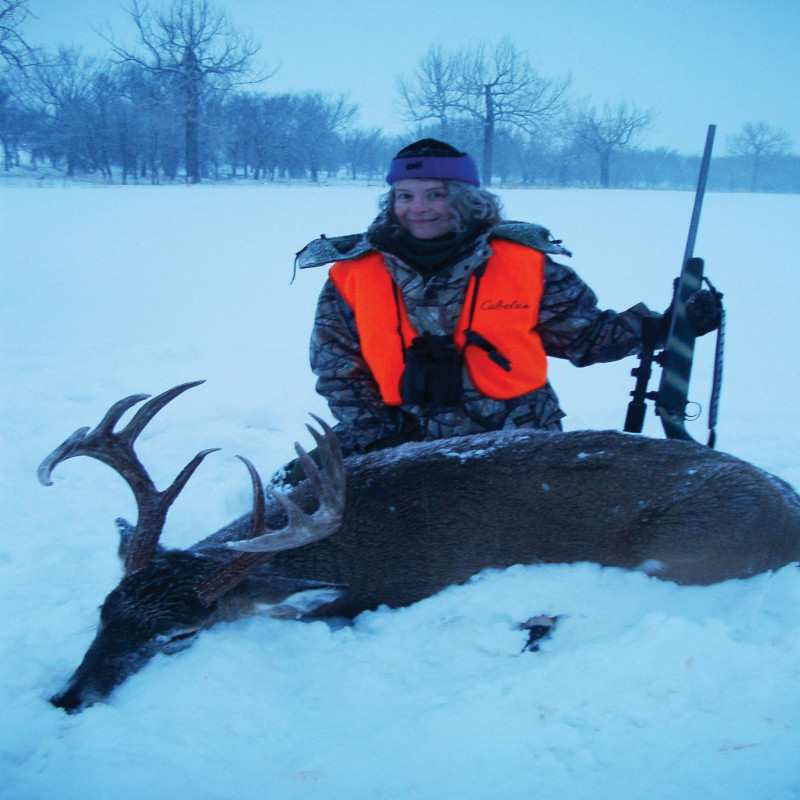Hot Nights, Cool Meals
 | Author:
Eileen Clarke, Rifles and Recipes
Author: Rifles and Recipes |
Eileen Clarke
Rifles and Recipes
There are two kinds of cooks. Ones who make just enough food to eat right now, and those who make a big meal one day, then forage on the leftovers for a couple of days. I’m that forager. And one thing I am really craving right now is a tasty elk or deer roast to slice thin over sourdough bread with mayo and salsa with a little lettuce and tomato from the garden. But no way am I lighting the kitchen stove when it’s this hot. Isn’t that why we have barbecues?
But barbecues don’t cook roasts evenly, someone will point out. And they turn the bottom surface into ½” of shoe leather. Not, I retort, when you cook indirectly. Aha.
Indirect cooking is perfect for larger pieces, be it an elk roast or greater Canada goose.
So, how does it work? Do you cook on propane? Light the fire on one end of the grill, then place the roast on the other. Do you use briquettes or wood? Start the fire in the middle, but before adding the meat, slide half the hot coals to one side of the grill and the rest to the other side, placing the roast in the middle. (And always assuming the fire is on one rack and the roast a few inches above it on a second rack.)
You’ll need a covered grill that produces even temperatures, whether you’re using propane, briquettes, or wood. The cover keeps the heat from escaping, while circulating it round and round the meat. Uneven temperature control creates bursts of heat that make it hard to predict cooking times and leads to stressful cooking at best, culinary disasters at worst. Indirect grilling is all about using the heat but not letting it sear the roast itself or turn the bottom ½” into shoe leather.
Indirect al Fresco Roast
Serves 6-8
Ingredients
2 pound rump roast, or tenderloin
1/2 cup softened butter
1 tablespoon freshly squeezed lemon juice
1 tablespoon chopped shallots
1 teaspoon salt
1 teaspoon coarse black pepper
2 teaspoons dried leaf tarragon
Cooking
1. Preheat the grill to 450˚. Trim and dry the roast. In one bowl, mix together the butter, lemon juice, and shallots until smooth. In a separate bowl, combine the salt, pepper, and tarragon.
2. Cut two long slits the length of the top of the roast, about 1 inch from the ends and 1 inch deep. (You want a “trough” to hold the butter, and not let it drip off, not only losing the flavor, but causing flare-ups.) Fill these two slits with the butter/shallot mixture. Rub the tarragon mixture into the top of the roast.
3. Before starting the roast, measure its height by standing a ruler behind it. A 2-inch tall roast will take about 25 to 35 minutes at 450˚ for rosy rare (125˚F on the meat thermometer). Allow about 1/2 minute for each degree higher you want; about 130˚F for medium rare, 140˚F for slightly pink medium. Do not cook it any more than that. Remove the roast from the grill 5 to 7˚F below your ideal finished temperature to allow for counter rise.
4. That first serving: bring the roast to the table hot, and serve with your favorite potato salad, macaroni salad. When it’s cool, cover the leftover roast with a plastic or foil wrap and chill. Then for the next day or two, enjoy cool sandwiches until it’s gone.
****Feel free to substitute fresh tarragon for the dry. Or use another herb mixture: my other favorite is 1 tablespoon each of fresh basil and oregano blended with 2 chopped green onions in 2 tablespoons of butter. Salt and pepper as above.
Eileen’s Slice of the Wild cookbook offers 100 big game meat recipes, for all sorts of cuts, with many cooking methods. Go to her website and enter the phrase MT43News in the coupon box and you’ll get $5 off of any of Eileen’s wild game cookbooks: https://www.riflesandrecipes@gmail.com/406-521-0273.
Article Images
Click on Image Thumbnail(s) to view fullsize image
PhotoCredit: Eileen Clarke
Image 1 Caption: Eileen Clarke with her kill
Photo Credit: Eileen Clarke
